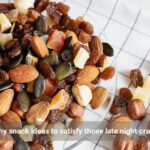Embark on a culinary journey to a healthier heart with this collection of delicious, low-sodium Banting recipes. The Banting diet, known for its emphasis on healthy fats and low carbohydrates, is adapted here to specifically address the needs of those seeking to reduce sodium intake. Discover vibrant breakfast options, satisfying lunch and dinner choices, and even guilt-free snacks and desserts, all while prioritizing heart health. Prepare to savor flavorful dishes that nourish your body and delight your taste buds, proving that healthy eating doesn’t have to compromise on taste.
This guide provides detailed, step-by-step instructions, nutritional information, and visually appealing descriptions for each recipe. We explore the principles of the Banting diet, highlighting its unique approach to low-sodium cooking and contrasting it with other dietary methods. Practical tips for meal planning, efficient preparation, and overcoming common challenges are included to ensure your success in adopting this heart-healthy lifestyle.
Introduction to Low-Sodium Banting Recipes

Embarking on a low-sodium Banting diet offers a powerful strategy for bolstering heart health. This approach combines the principles of the Banting diet, emphasizing low-carbohydrate, high-fat consumption, with a strict limitation on sodium intake, creating a synergistic effect beneficial for cardiovascular well-being. By reducing sodium, you lower blood pressure, a significant risk factor for heart disease, stroke, and kidney problems. The Banting diet’s focus on healthy fats and protein further supports heart health by improving cholesterol profiles and promoting satiety, aiding in weight management—another crucial factor in cardiovascular health.
The Banting diet, unlike many other low-sodium diets, isn’t solely focused on sodium restriction. It’s a comprehensive dietary approach that prioritizes whole, unprocessed foods, minimizing refined carbohydrates, sugars, and processed foods, many of which are high in sodium. While other low-sodium diets may permit certain processed foods, the Banting approach emphasizes natural sources of nutrients, ensuring a holistic and balanced approach to healthy eating. This difference leads to a more sustainable and satisfying dietary experience, encouraging long-term adherence.
Types of Low-Sodium Banting Recipes Covered
This collection of recipes will showcase the versatility and deliciousness of a low-sodium Banting lifestyle. Expect a vibrant array of dishes, from hearty, flavorful mains like succulent roasted chicken with lemon and herbs (imagine the golden-brown skin glistening, the aroma of herbs filling the air, and the tender, juicy meat falling effortlessly from the bone) to lighter, refreshing salads bursting with colorful vegetables and healthy fats (picture crisp lettuce leaves, vibrant red tomatoes, and creamy avocado slices, all tossed in a zesty, low-sodium vinaigrette). We will explore flavorful soups and stews, packed with nourishing vegetables and protein, offering warmth and satisfaction. Finally, we’ll also delve into delectable desserts, demonstrating that a healthy heart doesn’t mean sacrificing indulgence; imagine a rich, creamy coconut panna cotta, subtly sweetened and completely sodium-free, a testament to the satisfying possibilities of low-sodium Banting. Each recipe is carefully crafted to minimize sodium while maximizing flavor, proving that healthy eating can be both delicious and heart-healthy.
Breakfast Recipes
Starting your day with a heart-healthy, low-sodium Banting breakfast sets the tone for a day of mindful eating. These recipes are designed to provide sustained energy without compromising your cardiovascular health, focusing on nutrient-rich ingredients that are naturally low in sodium. Each recipe offers a delicious and satisfying start to the day, contributing to overall well-being.
Low-Sodium Banting Breakfast Recipes
The following table details three delicious and heart-healthy low-sodium Banting breakfast recipes. Each recipe emphasizes whole, unprocessed foods to provide sustained energy and support cardiovascular health. Remember to adjust portion sizes to meet your individual caloric needs.
| Recipe Name | Ingredients | Instructions | Nutritional Information (per serving – approximate) |
|---|---|---|---|
| Avocado & Egg Scramble | 1 ripe avocado, mashed; 2 eggs; 1 tablespoon chopped chives; pinch of black pepper; 1 tablespoon olive oil | 1. Heat olive oil in a pan over medium heat. 2. Add eggs and scramble until cooked through. 3. Stir in mashed avocado and chives. 4. Season with black pepper. | Calories: ~250; Fat: ~20g; Protein: ~12g; Carbohydrates: ~5g; Sodium: ~50mg |
| Berry Chia Seed Pudding | 1/4 cup chia seeds; 1 cup unsweetened almond milk; 1/2 cup mixed berries (strawberries, blueberries, raspberries); 1 teaspoon lemon juice; 1/4 teaspoon vanilla extract | 1. Combine chia seeds, almond milk, lemon juice, and vanilla extract in a jar or container. 2. Stir well and refrigerate overnight. 3. In the morning, stir in mixed berries. | Calories: ~200; Fat: ~10g; Protein: ~5g; Carbohydrates: ~25g; Sodium: ~20mg |
| Spinach and Feta Omelette | 2 eggs; 1 cup spinach, chopped; 1 tablespoon crumbled feta cheese (low-sodium); 1 tablespoon olive oil; pinch of black pepper | 1. Heat olive oil in a pan over medium heat. 2. Add spinach and sauté until wilted. 3. Whisk eggs and pour into the pan. 4. Sprinkle with feta cheese and black pepper. 5. Cook until omelette is set. | Calories: ~280; Fat: ~22g; Protein: ~15g; Carbohydrates: ~2g; Sodium: ~75mg |
Avocado & Egg Scramble Image Description
The image depicts a vibrant, rustic breakfast bowl. The creamy, pale green avocado is artfully mixed with the golden-yellow scrambled eggs, creating a visually appealing contrast. Specks of bright green chives add a pop of color and texture. The aroma is rich and savory, with the subtle creaminess of the avocado complementing the slightly eggy scent. The overall impression is one of freshness and wholesome goodness. This breakfast offers healthy fats from the avocado and high-quality protein from the eggs, contributing to satiety and sustained energy.
Berry Chia Seed Pudding Image Description
The photograph showcases a glass jar filled with a luscious chia seed pudding. The pudding’s creamy texture is evident, with the chia seeds subtly dispersed throughout. A vibrant mix of red strawberries, deep blue blueberries, and ruby raspberries provides a striking color contrast against the pale, creamy base. The aroma is delicately sweet and fruity, with a hint of lemon. The pudding is a visually appealing and refreshing breakfast option, providing fiber from the chia seeds and antioxidants from the berries, which support heart health by reducing oxidative stress.
Spinach and Feta Omelette Image Description
The image displays a perfectly cooked omelette, its golden-brown exterior hinting at a fluffy interior. The bright green spinach is evenly distributed throughout the omelette, creating a visually appealing contrast with the creamy white feta cheese. A subtle sheen from the olive oil adds to the omelette’s appetizing appearance. The aroma is subtly savory and cheesy, with a hint of the fresh spinach. The omelette is a protein-packed breakfast, providing essential nutrients for muscle building and overall health. The spinach is a good source of vitamins and minerals, while the low-sodium feta contributes to calcium intake, essential for bone health.
Meal Planning and Practical Tips
Successfully navigating a low-sodium Banting diet requires careful planning and practical strategies. This section provides a sample weekly meal plan, efficient cooking techniques, and solutions to common challenges, ensuring your journey to a healthier heart is both manageable and delicious. Remember to always consult with your doctor or a registered dietitian before making significant dietary changes.
Creating a low-sodium Banting meal plan doesn’t have to be daunting. Consistency is key, and incorporating meal prepping and smart substitutions can significantly simplify the process. The following sample plan utilizes recipes from the previous sections, showcasing how easy it is to build a balanced and flavorful weekly menu.
Sample Weekly Low-Sodium Banting Meal Plan
This plan offers a variety of flavors and textures, ensuring you don’t get bored with your meals. Remember to adjust portion sizes to meet your individual caloric needs.
| Day | Breakfast | Lunch | Dinner |
|---|---|---|---|
| Monday | Coconut Flour Pancakes (from Breakfast Recipes section) | Large Salad with grilled chicken breast and avocado | Salmon with roasted asparagus and cauliflower mash |
| Tuesday | Chia Seed Pudding with berries and nuts | Leftover Salmon and asparagus | Chicken Stir-fry with low-sodium soy sauce substitute and plenty of vegetables |
| Wednesday | Scrambled eggs with spinach and mushrooms | Tuna salad (made with mayonnaise and no added salt) in lettuce wraps | Beef and broccoli stir-fry (using low-sodium broth) |
| Thursday | Coconut Flour Pancakes (from Breakfast Recipes section) | Leftover Beef and broccoli | Baked cod with roasted Brussels sprouts and zucchini |
| Friday | Omelet with cheese and herbs | Large Salad with grilled shrimp and avocado | Pork chops with green beans and a side of mashed cauliflower |
| Saturday | Berry smoothie (made with unsweetened almond milk and berries) | Leftover Pork chops and green beans | Chicken and vegetable skewers (marinated in herbs and spices) |
| Sunday | Breakfast sausage (low-sodium) with scrambled eggs | Leftover Chicken and vegetable skewers | Roast chicken with roasted root vegetables |
Strategies for Efficient Low-Sodium Banting Cooking
Several techniques can streamline your low-sodium Banting cooking experience, saving you time and effort without compromising flavor.
Meal Prepping: Dedicate a few hours each week to prepping ingredients. Chop vegetables, cook proteins (like chicken breasts or ground beef), and portion them into containers for easy assembly throughout the week. Imagine a vibrant scene: neatly arranged containers filled with colorful chopped vegetables and perfectly cooked chicken breasts, ready to be combined into delicious meals with minimal effort. This visual organization significantly reduces cooking time during the week.
Smart Substitutions: Replace high-sodium ingredients with low-sodium or sodium-free alternatives. For instance, use low-sodium soy sauce substitutes, herbs, spices, and lemon juice to enhance the flavor of your dishes instead of relying on salt. Picture a colorful array of fresh herbs and spices, their aromatic scents filling your kitchen as you skillfully incorporate them into your culinary creations, replacing the need for salt. This creates a visually appealing and flavorful cooking experience.
Common Challenges and Solutions
Addressing common hurdles helps maintain adherence to the diet.
Challenge: Cravings for salty foods. Solution: Gradually reduce your sodium intake over time to lessen cravings. Increase your intake of potassium-rich foods (like avocados and spinach) to help balance electrolytes. Satisfy cravings with flavorful, low-sodium alternatives such as seasoned vegetables or unsweetened nuts. Imagine a vibrant bowl of colorful vegetables, roasted to perfection with a medley of aromatic herbs and spices, a satisfying and healthy alternative to salty snacks.
Challenge: Difficulty finding low-sodium ingredients. Solution: Shop at stores with a wide selection of natural and organic foods. Check nutrition labels carefully and opt for ingredients with minimal added sodium. Consider making some items from scratch, such as stocks or sauces, to ensure complete control over sodium content. Visualize a well-stocked pantry filled with a variety of low-sodium ingredients, neatly organized and readily available for quick and healthy meal preparation. This creates a sense of preparedness and ease in following your diet plan.
Challenge: Feeling fatigued or experiencing electrolyte imbalances. Solution: Ensure adequate hydration by drinking plenty of water throughout the day. Consult your doctor or a registered dietitian to monitor electrolyte levels and adjust your diet accordingly. Incorporate electrolyte-rich foods like avocados, leafy greens, and coconut water into your meal plan. Imagine yourself enjoying a refreshing glass of coconut water or a vibrant green smoothie, replenishing your electrolytes and providing a boost of energy for a successful day.
By embracing these low-sodium Banting recipes, you’re not just following a diet; you’re investing in a lifestyle change that prioritizes both flavor and well-being. The detailed recipes and meal planning suggestions empower you to take control of your heart health, creating a sustainable path towards a longer, healthier, and more enjoyable life. Remember, every delicious bite contributes to a healthier future. So, explore the recipes, embrace the process, and savor the results – a healthier heart and a palate delighted.
Expert Answers
Can I modify these recipes to suit my specific dietary needs or allergies?
Yes, many recipes can be adapted. Always check ingredients carefully and substitute as needed. For severe allergies, consult a doctor or registered dietitian.
How long can I store leftover Banting meals?
Leftovers should be stored properly in airtight containers in the refrigerator for up to 3-4 days. Always ensure food is thoroughly chilled before storing.
Are these recipes suitable for vegetarians or vegans?
Some recipes may be adaptable for vegetarian diets; however, the core Banting principles heavily rely on healthy fats and protein sources which may require careful modification for vegan adaptation.
What are some good low-sodium substitutes for common ingredients?
Consider using herbs and spices to enhance flavor instead of salt. Unsalted butter, low-sodium broths, and fresh vegetables are excellent low-sodium alternatives.


